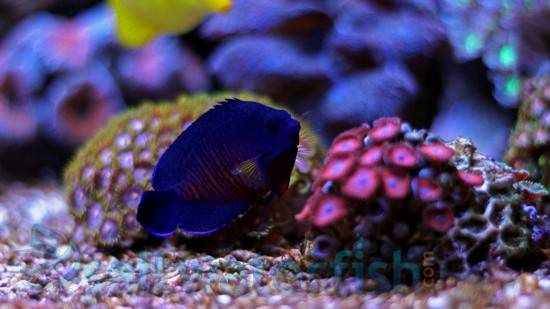Cleaner Shrimp
Lysmata amboinensis
(0 Reviews)

Cleaner Shrimp
Lysmata amboinensis
(0 Reviews)
{{ item.name }}
Size: {{ item.extra_field_3 }}
${{ getFormattedPrice(item.saleprice) }} ${{ getFormattedPrice(item.price) }}
To join the waiting list, click here
Free Shipping
With
$199.00
or more in Marine Life.
More details...
Cleaner Shrimp Care Facts
| Care Level: | Easy |
|---|---|
| Temperament: | Peaceful |
| Diet: | Omnivore |
| Origin: | Indian Ocean |
| Minimum Tank Size: | 10 gallons |
| Acclimation Time: | 2+ hours |
| Reef Safe: | Yes |
| Coral Safe: | Yes |
| Invertebrate Safe: | Yes |
| Lighting: | ~ |
| Placement: | ~ |
| Waterflow: | ~ |
The Cleaner Shrimp are larger shrimps and can be easily identified by the single white stripe down the back from head to tail, and flanked by two red stripes that terminate at its posterior region. the remaining body is orange in color with two white dots at the top edge, along with six white antennae. The Cleaner Shrimp, as the name suggests, is mainly known for its cleaning property, as it can clean parasites from fish and eels, and even the mouth of a large Grouper. The Cleaner Shrimp sheds its exoskeleton and undergo molting process. It does become very vulnerable and needs iodine supplement periodically which encourages them to shed their exoskeleton. They are very peaceful and can be kept with their own species and they don?t harm other inhabitants. The Cleaner Shrimp belongs to the class Crustacea and order Decapoda, which is characterized by two pair of antennae, three body parts, and five pairs of legs. The Cleaner Shrimp features long stiff antennae through which it feeds, catches, and tears apart with their pincers. It has extended eyes and highly developed abdomen which allows for quick movement.
The Beneficial Cleaner Shrimp (Lysmata amboinensis): A Helpful Asset for Saltwater Aquariums
The Beneficial Cleaner Shrimp (Lysmata amboinensis) is a fascinating and beneficial species that add beauty and utility to saltwater aquariums. Known for its vibrant colors and engaging behavior, this shrimp species has become popular among marine enthusiasts. Let's explore the Cleaner Shrimp's habitat, reef-safe nature, size, lifespan, diet, aquaculture potential, molts, symbiotic relationships, other common names, and compatible tank mates.
Habitat of the Cleaner Shrimp
The Cleaner Shrimp is native to the Indo-Pacific region, including the Red Sea and the western Indian Ocean. In the wild, they are often found in coral reefs and rocky crevices, seeking shelter and establishing their cleaning stations.
Reef-Safe Nature of the Cleaner Shrimp
The Cleaner Shrimp is entirely reef-safe and poses no threat to corals or other invertebrates. On the contrary, they are beneficial to the overall health of the reef ecosystem as they serve as natural cleaners, removing parasites and dead skin from the bodies of larger fish.
Size and Lifespan of the Cleaner Shrimp
Cleaner Shrimp are relatively small, typically reaching lengths of about 2 to 3 inches (5 to 7.5 cm). With proper care, they can have a lifespan of up to two years in a well-maintained aquarium.
Diet and Feeding Habits of the Cleaner Shrimp
In their natural habitat, Cleaner Shrimp are opportunistic omnivores, feeding on various food sources, including plankton, algae, parasites from host marine life, and detritus. In a home aquarium, they will readily accept a varied diet consisting of high-quality frozen and live foods such as brine shrimp, mysis shrimp, and marine pellets.
Aquaculture Potential of the Cleaner Shrimp
The Cleaner Shrimp is readily available in the aquarium trade, and there have been limited successful efforts in breeding and propagating them through aquaculture. Captive-bred specimens are more sustainable and help reduce the pressure on wild populations but have yet to be widely available to hobbyists.
Molting Behavior of the Cleaner Shrimp
Like other shrimp species, the Cleaner Shrimp undergoes molting to grow and regenerate their exoskeleton. During this process, they may become more reclusive and vulnerable to predation until their new exoskeleton hardens.
Symbiotic Relationships of the Cleaner Shrimp
The Cleaner Shrimp is well-known for its symbiotic relationship with larger fish species. They set up cleaning stations on the reef, where they actively remove parasites, dead skin, and debris from the bodies of visiting fish. In return, the fish tolerate the shrimp's presence, allowing them to perform their cleaning duties without aggression.
Other Common Names of the Cleaner Shrimp
In addition to the name "Cleaner Shrimp," this species is also known as the "Skunk Cleaner Shrimp" or "Pacific Cleaner Shrimp."
Five Compatible Tank Mates for the Cleaner Shrimp
- Peaceful and popular, clownfish are excellent tank mates for the Cleaner Shrimp.
- Firefish (Nemateleotris magnifica) share a compatible tank environment with the shrimp.
- Royal Gramma (Gramma loreto): Its vibrant colors complement the Cleaner Shrimp's beauty.
- Certain species of blennies are compatible tank mates that add diversity and activity to the aquarium.
- Some species of dwarf angelfish can coexist harmoniously with the Cleaner Shrimp, creating a dynamic and captivating display.
In conclusion, the Beneficial Cleaner Shrimp (Lysmata amboinensis) is a valuable and engaging asset for saltwater aquariums. Their cleaning behavior benefits both the fish and the overall health of the reef ecosystem. Aquarists can enjoy the beauty and usefulness of these remarkable shrimp by providing them with a suitable environment, compatible tank mates, and proper care.
Currently Cleaner Shrimp does not have any reviews.















